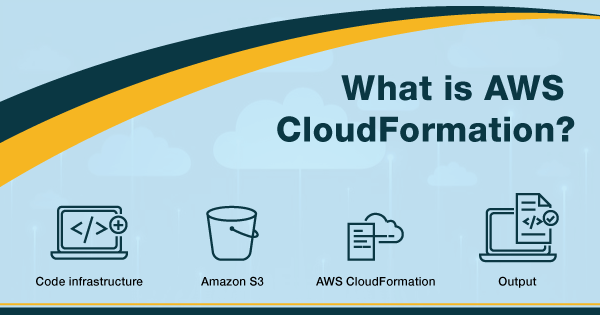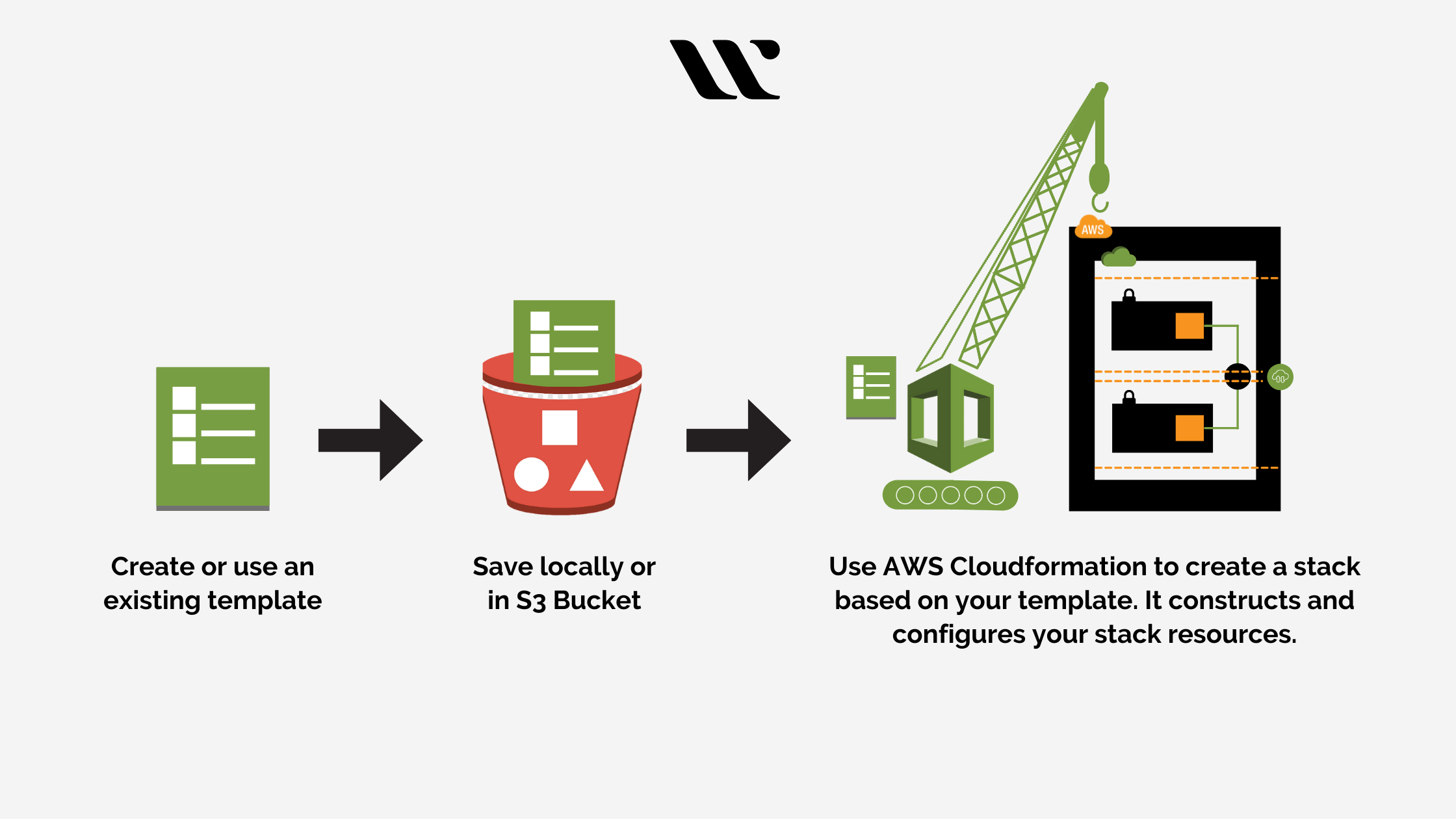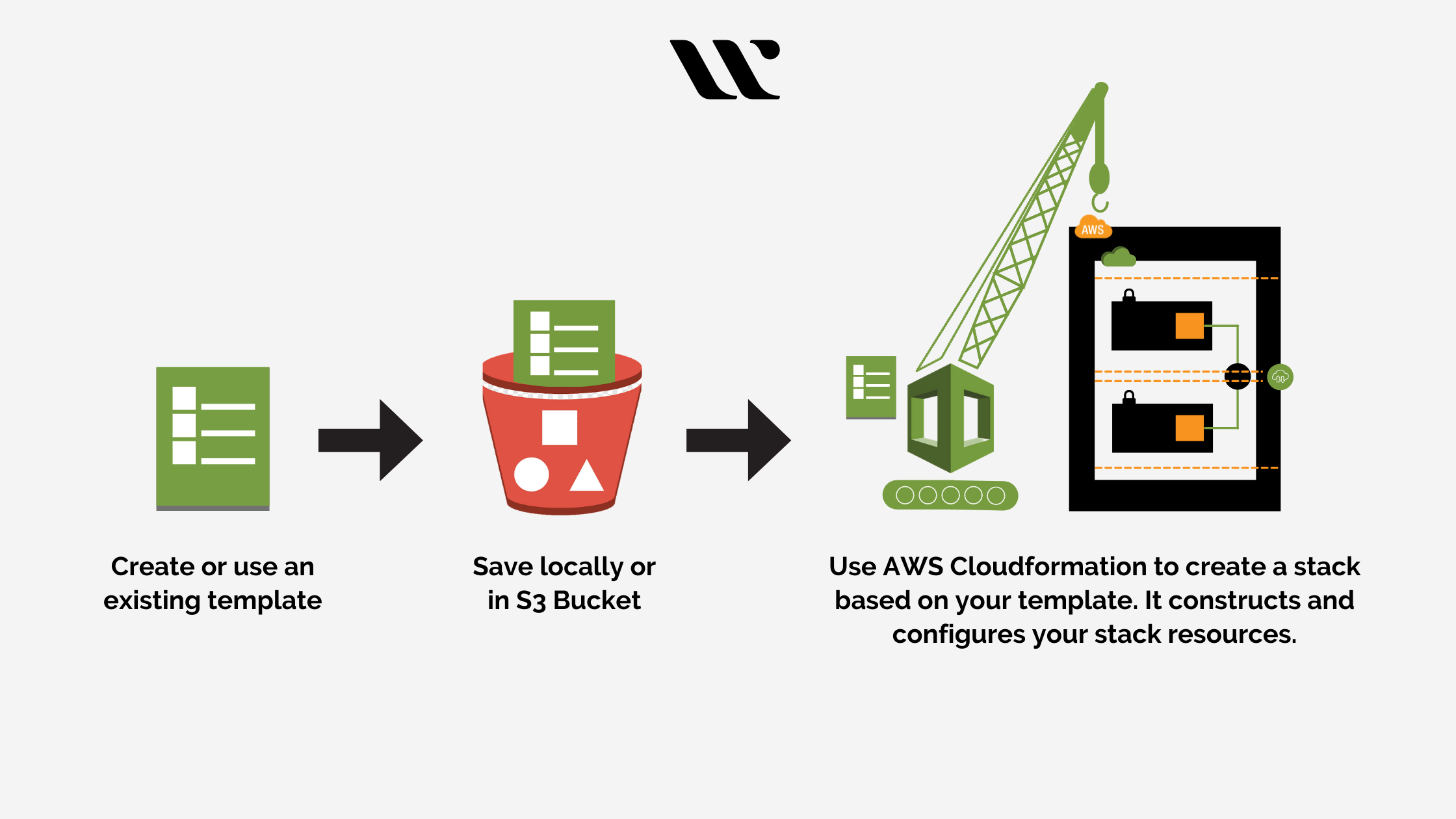AWS CloudFormation is a dedicated service offered by Amazon for helping the users set up and model the AWS resources. It allows you to spend less time and focus upon managing the AWS resources, and direct your focus towards the applications that run within AWS. You can create a template that gives a description of the resources within AWS that you want, such as Amazon RDS DB instances or Amazon EC2 instances.
CloudFormation intends to take optimal care of configuration and provisioning of those AWS resources for the users. There is no more necessity of creating or configuring these resources individually, as AWS CloudFormation takes proper care of that. In this article, you will know more details upon AWS CloudFormation, to understand its operations and efficacy.
Working of AWS CloudFormation
AWS CloudFormation operates on the stack concept. It gives you the potential of creating and deleting AWS resources collectively with respect to a unit. The users will be defining the characteristics associated with mappings, stack parameters, output values, and resource properties. The users will do it through a template, which will be a JSON-compliant file.
AWS CloudFormation allows you to write or create your template right from the start, or you can also use one of the example templates pre-offered by AWS. Along with that, the users are allowed to use several AWS products within CloudFormation, such as Amazon Elastic Beanstalk, Amazon RDS, and Amazon EC2.
While you are creating a stack, AWS CloudFormation makes specified service calls upon AWS. It intends to configure and provision the AWS resources! CloudFormation will be able to perform only the actions that you have got permission to do. For instance, if you wish to create Amazon EC2 instances with AWS CloudFormation, then you will need permissions for it. Along with that, you will also need permissions for deleting the stacks and terminating the instances.
For managing the permissions, the individuals can use AWS Identity and Access Management. Check out this link, to know more about AWS IAM! Following that, the calls that AWS CloudFormation processes are declared by the dedicated templates.
For creating or modifying a CloudFormation template within YAML or JSON, you will need to use the AWS CloudFormation Designer. Create your account and start designing! You can also prefer other text editors to do the same, but AWS designer is an ideal platform to derive effectiveness. The CloudFormation template will elaborate on the resources you want and the settings associated with them. For instance, if you wish to create one EC2 instance, then your template will declare the same and describe the properties.
Once you have created the template, save it either in the S3 bucket or locally. Make sure you save it with an extension such as .txt, .yaml, or .json. Create the CloudFormation stack by specifying the Amazon S3 URL or the template file location over your local computer. If the template consists of some parameters, then give the input values for the same. And, then you can proceed towards creating the stack. The parameters enable you to enter values for the CloudFormation template. With it, you will be able to customize the resources, every time you intend to create a stack.
Remember that, if you are specifying or calling a template that is stored locally, then CloudFormation will automatically upload it onto the S3 bucket, within the AWS account. CloudFormation is destined to create buckets for all of the regions where you will be uploading a template file. The buckets within CloudFormation are accessible by all who have Amazon S3 permissions enabled within the account.
Why Do We Need AWS CloudFormation?
For creating an architecture to support acceptance, production, and test environments, you will need AWS CloudFormation, which will help you carry out certain activities for the same. The activities carried out by CloudFormation for building the respective architecture are:
- Launching an instance.
- Creating LoadBalancers.
- Making required installations
- Attaching instance to the LoadBalancers.
- Creating RDS and configuring the EC2 security group, DBSecurity group, DBSubnet group, and DBParameter group.
- Creating & Configuring the security groups
- Creating auto-scaling groups
AWS CloudFormation template is a JSON file that is intended to be a powerful tool for managing all of these things. It specifies the necessity of resources, and CloudFormation powers you with resource provisioning in a predictable tangent.
Working Scenarios of AWS CloudFormation
AWS CloudFormation allows you to deploy or update the template and its resource collection, with the help of AWS Management Console, APIs, and AWS Command Line Interface. AWS CloudFormation use cases are not charged additionally, as you only have to pay for the AWS resources that are essential for running your dedicated applications. So, you can conclude that AWS CloudFormation is Infrastructure as Code, which means you can read, reuse and review with it. Below are some of the working scenarios of AWS CloudFormation, that will help you get better clarity on AWS CloudFormation.
-
Simplification to Infrastructure Management
If you have a web application that has scalable properties and a back-end database, you can prefer using an Auto Scaling Group. Along with that, you can also use Elastic Load Balancing LB and Amazon RDS database instances for the purpose.
Without CloudFormation, you will be using each of the individual services for provisioning these resources. After creating the resources, you will again need to configure all of those resources to work together. All of these tasks then intend to add more time & complexity before you can get your application to run.
Therefore, with the use of AWS CloudFormation, you can create a template or use the existing one for better management. The CloudFormation template highlights all of the resources, and their associated properties. On using that template for the creation of the CloudFormation stack, the platform provisions the load balancer, database, and Auto Scaling group for you.
Once the stack is created, the AWS resources are now online and running seamlessly. You can also choose to delete the stack easily, which will eliminate all of the resources executing within it. Therefore, with the use of AWS CloudFormation, you can expect to easily manage the infrastructure with utmost simplification.
-
Quick Replication of the Infrastructure
In case, your application demands more availability, then you will need to replicate it into multiple regions. It is because, when one region becomes unavailable, the users will be able to use your application through another region. There is an obvious challenge that you need to face while replicating the application, which is that you need to replicate the resources as well. It is essential for you to record all of the resources as per the demands of the application. But, along with that, you must also configure & provision all of these resources within each region.
You can reuse the AWS CloudFormation template, for creating the resources within a consistent & repeatable manner. AWS CloudFormation allows reusability of the templates, and you can do it by describing the resources once, and by provisioning the same around multiple regions. In this way, you will be able to replicate the infrastructure to multiple regions at ease.
-
Controlling and Tracking Changes Made to the Infrastructure
For some of the cases, there might be certain resources that need an upgrade. For instance, you might have a need or urge to upgrade to high-performing instances within the Auto Scaling launch configuration. And, with it, you can reduce the total number of instances within the group. Manual control, track changes, and upgrades are quite complex, and you will have to remember the whereabouts of the changed resources.
Therefore, with the use of AWS CloudFormation, the template will describe the provisioned resources and will elaborate upon the settings. Therefore, it will be easy for you to track all the infrastructure changes between these text file templates. You can also integrate a version control system along with the templates to get an idea of the exact changes made to the infrastructure. Along with that, you can also track who made those changes and when. In case you wish to reverse those changes within the infrastructure, you can go ahead and use the previous template version. Hence, controlling & tracking the infrastructure changes is convenient with AWS CloudFormation.
Parting Words
These are a few of the details associated with AWS CloudFormation. These insights elaborate upon the core CloudFormation functionality and convenience for the users to run their applications. It automates the best practices and scales your infrastructure on a worldwide level. The best part is that it allows you to integrate CloudFormation with other AWS services. Not just that, but you will be proficient enough to manage the private and third-party resources.
So, if you intend to use AWS CloudFormation, then it is better to gain a few details about it. Having knowledge of what you are about to integrate, will help you explore the true potential of AWS CloudFormation and avail seamlessness for executing your applications. The free tier of AWS CloudFormation allows 1000 handler operations every month per account. And for the handler operation, you need to pay $0.0009 per operation. So, in this way, AWS CloudFormation services are also cheap for use! So, try it all by yourself to know about its efficacies!
- Best 15+ AWS Developer Associate hands-on labs in 2024 - July 24, 2024
- Containers vs Virtual Machines: Differences You Should Know - June 24, 2024
- Databricks Launched World’s Most Capable Large Language Model (LLM) - April 26, 2024
- What are the storage options available in Microsoft Azure? - March 14, 2024
- User’s Guide to Getting Started with Google Kubernetes Engine - March 1, 2024
- Navigating the Power of Amazon Elastic File System (EFS) - February 15, 2024
- Microsoft Power BI – Sandbox | Everything you should know - January 3, 2024
- Top Alibaba Cloud Interview Questions and Answers - December 13, 2023



